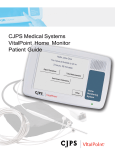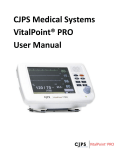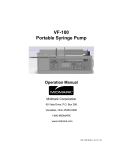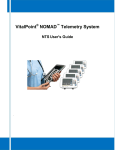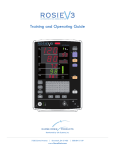Download Delphi DL-00035 User's Manual
Transcript
Delphi Medical Systems VitalPoint Home Monitor Patient Guide Manufactured by: Delphi Medical Systems 5725 Delphi Drive Troy, Michigan 48098-2815 U.S.A. CE0086 The information in this document is subject to change without notice. This document contains proprietary information that is protected by copyright. No part of this document may be reproduced in any manner, in whole or in part (except for brief excerpts in reviews and scientific papers), without the prior written consent of Delphi Medical Systems. Delphi Medical Systems makes no warranty of any kind on this material, including but not limited to, the implied warranties of merchantability and fitness for a particular purpose. Delphi Medical Systems shall not be liable for errors contained herein or for incidental or consequential damages concerning the furnishing, performance, or use of this material. Before using any Delphi Medical Systems product, be sure to read carefully and understand all manuals provided with the product. Delphi Medical Systems Remote Device Connectivity complies with the U.S. Health Insurance Portability and Accountability Act (HIPAA) protecting the security and privacy of health data. It is recommended that the healthcare facility ensures that patients complete all necessary paperwork so that the facility complies with the HIPAA requirements. This equipment complies with Part 68 of the U.S. Federal Communications Commission (FCC) rules and the requirements adopted by the American Council for Terminal Attachments (ACTA). On the back of the Delphi Medical Systems VitalPoint™ Home Monitor is a label that contains, among other information, a product identifier in the format US:AAAEQ##TXXXX. If requested, this number must be provided to the telephone company. The Universal Services Ordering Code (USOC) jack used to connect the VitalPoint Home Monitor to the premises’ wiring and telephone network must comply with the applicable FCC Part 68 rules and requirements adopted by the ACTA. ii DL-00035 Rev. 4 The ringer equivalence number (REN) is used to determine the number of devices that may be connected to a telephone line. Excessive RENs on a telephone line may result in the devices not ringing in response to an incoming call. In most, but not all, areas the sum of RENs should not exceed five (5). To be certain of the number of devices that may be connected to a line, as determined by the total RENs, contact the local telephone company. For products approved after July 23, 2002, the REN is part of the product identifier that has the format US:AAAEQ##TXXXX. The digits represented by ## are the REN without a decimal point (i.e., 03 is a REN of 0.3). For earlier products, the REN is separately shown on the label. If this VitalPoint Home Monitor causes harm to the telephone network, the telephone company will notify you in advance that temporary discontinuance of service may be required. But if advance notice isn’t practical, the telephone company will notify the customer as soon as possible. Also, you will be advised of your right to file a complaint with the FCC if you believe it’s necessary. The telephone company may make changes in its facilities, equipment, operations, or procedures that could affect the operation of the VitalPoint Home Monitor. If this happens, the telephone company will provide advance notice in order for you to make necessary modifications to maintain uninterrupted service. Connection to party line service is subject to state tariffs (U.S.). Contact the state public utility commission, public service commission, or corporation commission for information. If installed in a home with specially wired alarm equipment connected to the telephone line, ensure the installation of the VitalPoint Home Monitor does not disable the alarm equipment. If you have questions about what will disable alarm equipment, consult the telephone company or qualified installer. Electrical safety advisory: Parties responsible for equipment requiring AC power should consider including an advisory notice in their customer information suggesting the customer use a surge arrestor. Telephone companies report that electrical surges, typically lightning transients, are very destructive to customer terminal equipment connected to AC power sources. This has been identified as a major nationwide problem. DL-00035 Rev. 4 iii Classification This equipment is ETL listed. This equipment is classified as: • Class II • Type CF • IPX0 • Continuous operation iv DL-00035 Rev. 4 Explanation of Packaging and Labeling Symbols For indoor use only Caution, consult accompanying documents (month/year) Manufacture date (mm/yyyy) Do not use if package damaged Direct current power input, 15 V, 600 milliamperes Serial number Catalog number only U.S. federal law restricts this device to sale by or on the order of a physician On Off Class II device This end up Fragile/breakable Atmospheric pressure limitation 0.3 bar to 1.0 bar Storage temperature limitation -4°F to 122°F (-20°C to 50°C) Humidity limitation 10% to 95% IPX0 Ordinary protection Type CF DL-00035 Rev. 4 v Intended Use The VitalPoint Home Monitor is intended to be used as a clinical tool for remotely monitoring a patient’s health status at home or in another healthcare facility. The system is intended to guide patients through a set of scheduled activities whereby medical data (vital signs, symptoms, and medication compliance) is collected. The system is intended to transfer the collected data to a remote site where it is stored and reviewed by a clinician. The system is also intended to allow the clinician to modify the patient’s scheduled activities in response to the collected medical data or other information available to the clinician. The intent is to provide clinicians caring for patients outside the hospital with a means for keeping track of how the patients are doing without the patients having to come in for a checkup or requiring the clinician to go to the patients. It provides periodic remote monitoring of the patients self-reported symptoms or vital signs, including: • Non-invasive blood pressure • Blood glucose level • Oxygen saturation • Fluid status • Pulse rate • Prothrombin time • Temperature • Electrocardiogram (ECG) and heart rate monitors • Weight WARNING: THE VITALPOINT HOME MONITOR IS NOT AN EMERGENCY RESPONSE SYSTEM. THE DEVICE LABELING ADVISES PATIENTS TO CONTACT THEIR CAREGIVER, NURSE, OR DOCTOR; CALL LOCAL EMERGENCY NUMBER AS APPROPRIATE; OR GO TO THE EMERGENCY ROOM WHENEVER THEY FEEL THE NEED TO DO SO. THE VITALPOINT HOME MONITOR DOES NOT ANALYZE PATIENT INFORMATION, NOR DOES IT OFFER MEDICAL ADVICE. CONTRAINDICATIONS OVERVIEW CONTRAINDICATION: • USE OF THIS DEVICE IS CONTRAINDICATED IN APPLICATIONS REQUIRING AUTOMATED ARRHYTHMIA DETECTION. • THIS DEVICE IS NOT TO BE USED AS AN APNEA MONITOR. • THIS DEVICE IS NOT TO BE USED IN AN MRI ENVIRONMENT. • THIS DEVICE IS NOT TO BE USED IN AN OPERATING ROOM OR SURGICAL ENVIRONMENT. vi DL-00035 Rev. 4 The VitalPoint Home Monitor can also be configured to remind the patient to take medications at certain times of the day as well as to take requested vital signs measurements. The VitalPoint Home Monitor is set up for a specific patient’s needs by a clinician. While the VitalPoint Home Monitor is intended for use in adult and pediatric patients, the user interface is tailored for an adult operator. The VitalPoint Home Monitor is not intended for use on neonatal patients. Version Please refer to this patient guide for instructions on warnings, precautions, and additional information. Printed in U.S.A. DL-00035 Rev. 4 vii General Information This user manual provides information for users of the VitalPoint Home Monitor. For the sake of brevity, the terms “VitalPoint,” “monitor,” or “device” are sometimes used in this document to refer to the VitalPoint Home Monitor. IMPORTANT Users should read this entire patient guide before operating the VitalPoint Home Monitor. Failure to do so could result in personal injury and/or death. If you have questions about the information in this patient guide or about the safe operation of this system, contact your clinician. TYPOGRAPHICAL CONVENTIONS IN THIS USER MANUAL This guide contains warnings, precautions, and notes to help call your attention to the most important safety and operational aspects of the system. To help identify these items when they occur in the text, they are shown using the following typographical conventions: WARNING: STATEMENTS THAT DESCRIBE SERIOUS ADVERSE REACTIONS AND POTENTIAL SAFETY HAZARDS. PRECAUTION: STATEMENTS THAT CALL ATTENTION TO INFORMATION REGARDING ANY SPECIAL CARE TO BE EXERCISED BY THE PRACTITIONER AND/OR PATIENT FOR THE SAFE AND EFFECTIVE USE OF THE DEVICE. IMPORTANT: Statements that call attention to additional significant information about the device or a procedure. Note: Statements that provide supplemental information. viii DL-00035 Rev. 4 Warnings and Precautions WARNINGS OVERVIEW CRITICAL! EXPLOSION HAZARD. DO NOT USE IN THE PRESENCE OF FLAMMABLE ANESTHETICS. DO NOT INCINERATE UNIT. WARNING: 1. PACEMAKER PATIENTS: RATE METERS MAY CONTINUE TO COUNT THE PACEMAKER RATE DURING OCCURRENCES OF CARDIAC ARREST OR SOME ARRHYTHMIAS. DO NOT RELY ENTIRELY UPON RATE METER ALARMS. 2. THE VITALPOINT HOME MONITOR IS NOT AN EMERGENCY RESPONSE SYSTEM. THE DEVICE LABELING ADVISES PATIENTS TO CONTACT THEIR CAREGIVER, NURSE, OR DOCTOR; CALL LOCAL EMERGENCY NUMBER AS APPROPRIATE; OR GO TO THE EMERGENCY ROOM WHENEVER THEY FEEL THE NEED TO DO SO. THE VITALPOINT HOME MONITOR DOES NOT ANALYZE PATIENT INFORMATION, NOR DOES IT OFFER MEDICAL ADVICE. 3. DO NOT USE THE MONITOR NEAR SOURCES OF LIQUIDS SUCH AS SINKS, SHOWERS, OR BATHTUBS. 4. UNPLUG THE MONITOR BEFORE CLEANING. DO NOT SPRAY CLEANERS INTO THE RECEPTACLES. 5. DO NOT USE A MONITOR OR ANY ACCESSORY THAT SHOWS ANY SIGN OF DAMAGE. 6. DO NOT USE THE MONITOR IF THE MAIN MENU SCREEN IS NOT DISPLAYED PROPERLY WHILE CONNECTED TO AC POWER. 7. DEVICE INTERCONNECTIONS: THROUGH ITS OMD (OTHER MEDICAL DEVICE) PORT, THE VITALPOINT HOME MONITOR CAN BE CONNECTED TO EXTERNAL DEVICES. THE MONITOR SHOULD NOT BE CONNECTED TO DEVICES THAT ARE NOT DESCRIBED IN THIS MANUAL. 8. THE VITALPOINT HOME MONITOR CONTAINS A LITHIUM-ION BATTERY. ONLY TRAINED SERVICE PERSONNEL SHOULD REMOVE OR CHANGE THE BATTERY. 9. NON-INVASIVE BLOOD PRESSURE WARNINGS: • THE NON-INVASIVE BLOOD PRESSURE (NBP) CUFF SHOULD BE AT THE SAME LEVEL AS THE PATIENT’S HEART. IF THE NBP CUFF CANNOT BE PLACED AT THIS LEVEL, ADD TO MEASURED PRESSURE VALUES 1.4 mmHg FOR EACH 2 cm ABOVE HEART LEVEL, OR SUBTRACT 1.4 mmHg FOR EACH 2 cm BELOW HEART LEVEL. DL-00035 Rev. 4 ix WARNING: • IN SOME CASES, FREQUENT AND PROLONGED MEASUREMENTS CAN RESULT IN PETECHIA, ISCHEMIA, PURPURA, OR NEUROPATHY. CHECK THE CUFF SITE REGULARLY WHEN TAKING FREQUENT MEASUREMENTS OVER AN EXTENDED TIME PERIOD. ALSO CHECK FOR ANY SIGNS OF RESTRICTED CIRCULATION IN THE EXTREMITIES OF THE LIMB WHERE THE NBP CUFF IS WRAPPED. • BE SURE THE NON-INVASIVE BLOOD PRESSURE HOSE IS NOT BLOCKED OR KINKED DURING A MEASUREMENT. A BLOCKED OR KINKED HOSE COULD LEAD TO EXCESSIVE PRESSURE IN THE BLOOD PRESSURE CUFF, WHICH COULD CAUSE LIMB DAMAGE. IN THE EVENT THE CUFF NEEDS TO BE STOPPED DURING OPERATION DUE TO AN ERROR CREATED BY A BLOCKED OR KINKED HOSE, THE CUFF SHOULD BE REMOVED FROM THE ARM BY RELEASING THE VELCRO® STRAP OR PULLING/CUTTING THE HOSE OFF OF THE CONNECTOR. 10. PULSE OXIMETRY WARNINGS: • REPOSITION THE PULSE OXIMETRY SENSOR AT LEAST EVERY 4 HOURS (2 HOURS FOR POORLY PERFUSED PATIENTS). MOVE THE SENSOR IF YOU SEE ANY SIGNS OF SKIN IRRITATION OR IMPAIRED CIRCULATION. • ELEVATED LEVELS OF CARBOXYHEMOGLOBIN OR METHEMOGLOBIN IN MONITORED PATIENTS CAN RESULT IN INACCURATE PULSE OXIMETRY READINGS. • A PULSE OXIMETER SHOULD BE CONSIDERED AS AN EARLY WARNING DEVICE. AS A TREND TOWARD PATIENT DEOXYGENATION IS INDICATED, BLOOD SAMPLES SHOULD BE ANALYZED BY A LABORATORY CO-OXIMETER. 11. PROBES AND CABLES ARE DESIGNED FOR USE WITH SPECIFIC MONITORS. VERIFY COMPATIBILITY AND USE ONLY APPROVED ACCESSORIES WITH VITALPOINT. USING NON-APPROVED ACCESSORIES MAY RESULT IN DEGRADED PERFORMANCE, DAMAGE TO THE MONITORING EQUIPMENT, OR IN HARM TO THE PATIENT, AND MAY VOID WARRANTY COVERAGE. 12. TO AVOID AN ELECTRICAL SHOCK HAZARD, THE CONDUCTIVE PART OF THE ELECTRODES SHOULD NOT BE ALLOWED TO COME IN CONTACT WITH OTHER CONDUCTIVE OBJECTS, INCLUDING EARTH. 13. DO NOT INTRODUCE ANY ADDITIONAL PATIENT CONNECTION THAT MAY PRODUCE ELECTRICAL CURRENT. VITALPOINT APPLIES APPROXIMATELY 2 MICROAMPERES (2 µA). 14.ACCESSORIES SHOULD BE DISPOSED OF ACCORDING TO THE MANUFACTURER’S INSTRUCTIONS ON PACKAGING. x DL-00035 Rev. 4 PRECAUTIONS OVERVIEW PRECAUTION: 1. U .S. FEDERAL LAW RESTRICTS THIS DEVICE TO SALE BY OR ON THE ORDER OF A PHYSICIAN. 2. THE VITALPOINT HOME MONITOR IS NOT INTENDED TO BE A PRIMARY SOURCE OF MEDICAL INFORMATION. CONTACT CLINICIAN WITH QUESTIONS. 3. FOR CONTINUED OPERATION, ALWAYS CONNECT THE MONITOR TO A WALL OUTLET. FAILURE TO DO THIS CAN LEAD TO AN INTERRUPTION OF MONITORING. 4. THERE ARE NO USER-SERVICEABLE PARTS IN THIS DEVICE. 5. PORTABLE AND MOBILE RADIO-FREQUENCY (RF) COMMUNICATIONS EQUIPMENT CAN AFFECT THE VITALPOINT HOME MONITOR. IF THE VITALPOINT HOME MONITOR DOES NOT APPEAR TO BE WORKING NORMALLY, TRY TO RELOCATE OR REORIENT THE VITALPOINT HOME MONITOR. 6. USE OF ACCESSORIES NOT APPROVED FOR USE WITH THE VITALPOINT HOME MONITOR MAY RESULT IN INCREASED EMISSIONS OR DECREASED IMMUNITY OF THE VITALPOINT HOME MONITOR. REFER TO THE APPROVED ACCESSORIES LIST FOR THE VITALPOINT HOME MONITOR. 7. THE VITALPOINT HOME MONITOR SHOULD NOT BE USED ADJACENT TO OR STACKED WITH OTHER EQUIPMENT; AND THAT IF ADJACENT OR STACKED USE IS NECESSARY, THE VITALPOINT HOME MONITOR SHOULD BE OBSERVED TO VERIFY NORMAL OPERATION. 8. THESE CHEMICALS MAY DAMAGE THE MONITOR’S FRONT PANEL: ACETALDEHYDE, ACETONE, AMMONIA, BENZENE, HYDROXYTOLUENE, METHYLENE CHLORIDE, OR OZONE. DO NOT USE THOSE CHEMICALS OR CLEANSERS CONTAINING N-ALKYLDIMETHYLBENZYLAMMONIUM CHLORIDE. 9. NON-INVASIVE BLOOD PRESSURE PRECAUTIONS: • DO NOT APPLY THE NON-INVASIVE BLOOD PRESSURE CUFF ON THE SAME LIMB AS THE SpO2 SENSOR. DURING BLOOD PRESSURE MEASUREMENTS, THE PERFUSION IS TEMPORARILY REDUCED, WHICH CAN RESULT IN INACCURATE PULSE OXIMETRY READINGS. • DO NOT ALLOW THE NON-INVASIVE BLOOD PRESSURE CUFF OR HOSE TO COME IN CONTACT WITH FLUIDS. IF THIS OCCURS, ALLOW TO DRY THOROUGHLY BEFORE USE. CHECK THE HOSE AND CUFF FREQUENTLY FOR SIGNS OF DAMAGE OR DEBRIS. AN OBSTRUCTION IN THE HOSE MAY INTERFERE WITH INFLATION AND DEFLATION, RESULTING IN INACCURATE NON-INVASIVE BLOOD PRESSURE READINGS. DL-00035 Rev. 4 xi PRECAUTION: • TO OBTAIN ACCURATE BLOOD PRESSURE READINGS, KEEP THE LIMB AND THE CUFF AS STILL AS POSSIBLE. • NON-INVASIVE BLOOD PRESSURE MEASUREMENTS MAY NOT BE ACCURATE IF THE PATIENT IS CONVULSIVE, EXPERIENCING TREMORS, OR IS DEFIBRILLATED DURING THE MEASUREMENT. 10. PULSE OXIMETRY PRECAUTIONS: • READ INSTRUCTIONS PROVIDED WITH THE PULSE OXIMETRY SENSOR TO UNDERSTAND THE BEST APPLICATION TECHNIQUE AND ALL RELEVANT SAFETY INFORMATION. • DO NOT APPLY THE PULSE OXIMETRY SENSOR ON THE SAME LIMB AS THE NON-INVASIVE BLOOD PRESSURE CUFF. DURING BLOOD PRESSURE MEASUREMENTS, THE PERFUSION IS TEMPORARILY REDUCED, WHICH CAN RESULT IN INACCURATE PULSE OXIMETRY READINGS. • BRIGHT LIGHT CAN CREATE PROBLEMS WITH THE PULSE OXIMETRY MEASUREMENTS, RESULTING IN INACCURATE PULSE OXIMETRY READINGS. IF THE SENSOR IS IN A PLACE WHERE IT MAY BE EXPOSED TO BRIGHT LIGHT, COVER THE SENSOR WITH SOME OPAQUE MATERIAL TO BLOCK THE LIGHT. • PULSE OXIMETRY READINGS MAY BE INACCURATE IN THE PRESENCE OF TOO MUCH MOTION OR IF THE PATIENT HAS TREMORS. IF QUESTIONABLE READINGS ARE OBTAINED, RE-CHECK THE VITAL SIGNS BY ALTERNATE MEANS BEFORE TAKING MEDICATION. 11. SHOULD THE AC ADAPTER’S GREEN LIGHT NOT REMAIN ON WHILE PLUGGED INTO AN AC OUTLET, REPORT THE PROBLEM TO YOUR CLINICIAN AND DISCONTINUE MONITOR USE UNTIL THE PROBLEM CAN BE IDENTIFIED AND CORRECTED. 12. YOU SHOULD NOT RELY SOLELY ON THE MONITOR REGARDING WHEN TO TAKE MEDICATIONS. YOU SHOULD CONSULT YOUR PHYSICIAN BEFORE TAKING ANY PRESCRIPTION OR NONPRESCRIPTION MEDICATION OR CHANGING ANY MEDICATION REGIMENS. VITALPOINT IS INTENDED AS A REMINDER SYSTEM ONLY. xii DL-00035 Rev. 4 PRECAUTION: 13. ECG/RESPIRATION PRECAUTIONS: • LINE ISOLATION MONITOR TRANSIENTS MAY RESEMBLE ACTUAL CARDIAC WAVEFORMS AND THUS INHIBIT HEART RATE ALARMS. TO AVOID THE RISK OF THIS HAPPENING, FOLLOW THE DIRECTIONS FOR PROPER ELECTRODE PLACEMENTS, AND KEEP THE ECG LEAD WIRES AWAY FROM SOURCES OF LINE NOISE. • TO AVOID LARGE OFFSET POTENTIALS DUE TO POLARIZATION OF ELECTRODES, BE SURE TO USE ONLY ELECTRODE TYPES SPECIFIED FOR THIS DEVICE, AND BE SURE THAT ALL ELECTRODES USED ARE OF THE SAME TYPE. 14. FOLLOW THE MANUFACTURER’S INSTRUCTIONS FOR USE WHEN USING A GLUCOSE METER AND STRIPS. 15. FOLLOW THE MANUFACTURER’S INSTRUCTIONS FOR USE WHEN USING A FLUID STATUS MONITOR. 16. FOLLOW THE MANUFACTURER’S INSTRUCTIONS FOR USE WHEN USING A PROTHROMBIN TIME METER. DL-00035 Rev. 4 xiii Contents Classification Explanation of Packaging and Labeling Symbols Intended Use Contraindications Overview General Information Warnings and Precautions Warnings Overview Precautions Overview Introduction Monitor Features and Controls Before You Get Started Choosing a Location for the Monitor Turning the Monitor On Dimming Feature Power Supply Phone Connection Monitor Setup Important Reminders For Help Operating the VitalPoint Home Monitor Selecting Options Main Menu Screen Reporting Symptoms Taking Measurements Measuring Blood Pressure Measuring Pulse Oximetry Measuring Temperature Measuring Blood Glucose Measuring Prothrombin Time Measuring Fluid Status Measuring Weight Measuring ECG Medication Reminder Viewing Nurse’s Instructions Viewing Setup Options Concluding Activities Trademarks Disclaimer xiv DL-00035 Rev. 4 iv v vi vi viii ix ix xi 1 2 4 4 4 4 4 5 5 6 7 8 8 9 11 13 14 15 15 16 16 17 18 18 19 20 21 23 25 25 Introduction Thank you for using the VitalPoint Home Monitor. The monitor allows your clinician to monitor your status while you are at home or in another healthcare facility. The monitor collects vital signs and other information from you and sends it to your clinician over a phone line. It can check your blood pressure, oxygen saturation, pulse rate, respiration rate, ECG, and temperature, and can be connected to devices such as a digital weight scale, prothrombin time meter, fluid status monitor, and a blood glucose meter. Your clinician can also use the monitor to send you messages reminding you to conduct certain tests or take your medication. WARNING: THE VITALPOINT HOME MONITOR IS NOT AN EMERGENCY RESPONSE SYSTEM. THE DEVICE LABELING ADVISES PATIENTS TO CONTACT THEIR CAREGIVER, NURSE, OR DOCTOR; CALL LOCAL EMERGENCY NUMBER AS APPROPRIATE; OR GO TO THE EMERGENCY ROOM WHENEVER THEY FEEL THE NEED TO DO SO. THE VITALPOINT HOME MONITOR DOES NOT ANALYZE PATIENT INFORMATION, NOR DOES IT OFFER MEDICAL ADVICE. DL-00035 Rev. 4 1 Monitor Features and Controls Power on indicator LED; “on” when lit Main screen (dims after 5 minutes) Power switch Battery charging indicator LED; power connected and battery charging when lit Serial number Catalog number Service access CAUTION: Do not remove; for qualified service personnel only Phone jack receptacle Reserved for future use 2 DL-00035 Rev. 4 Fluid status monitor receptacle (1) Glucose meter receptacle (2) Weight scale receptacle (3) Pulse oximeter receptacle (SpO2) Blood pressure receptacle (NBP) Electrocardiogram receptacle (ECG) Temperature probe receptacle (TEMP) Fluid status monitor receptacle (1) Glucose meter receptacle (2) Weight scale receptacle (3) Power receptacle USB port for Delphi approved accessories only Reserved for future use Phone jack receptacle DL-00035 Rev. 4 3 BEFORE YOU GET STARTED Some important things to note before using the VitalPoint Home Monitor: Choosing a Location for the Monitor Work with your clinician to identify a convenient location for the monitor. The VitalPoint Home Monitor should be placed in a location that is: • Near a power outlet and a phone jack. • Flat and stable. A tabletop is a good choice. • Away from common areas. Avoid areas with a lot of foot traffic to help prevent injury from tripping on cords and to help prevent the cords from being disconnected. • Away from a water source. Avoid areas near sinks, showers, and bathtubs. Turning the Monitor On Turn the monitor on by flipping the switch located on the back of the monitor. A green light on the front is lit when the monitor is powered on. The monitor should be left on at all times while in your home. Dimming Feature The monitor’s main screen will automatically dim after 5 minutes so that the brightness will not disturb a patient who wishes to sleep. A simple tap on the screen or any monitor activity will return the screen to its original brightness. Power Supply The monitor should be kept plugged into an AC power outlet at all times while in your home. Connect the AC adapter to the monitor by plugging the round connector into the receptacle on the right side of the monitor. Plug the other end of the AC adapter into an AC power outlet. The green light on the plug indicates proper connection of the adapter. Use only the power supply cord that came with the monitor. The monitor contains a lithium-ion rechargeable battery. In the event of a power outage, the monitor can function on this battery for up to 5 hours. If power is out for a longer period of time, contact your clinician. 4 DL-00035 Rev. 4 Phone Connection The monitor should remain connected to a phone line at all times. Connect the phone line by plugging one end into the receptacle on the right-hand side of the monitor and the other into a wall phone jack. The monitor will need to use the phone line for brief periods during the day to send any reported data to your clinician. While dialing, the following message will appear on the monitor: “Sending Data Now. This may take a few minutes. Please do not use your telephone while the data is sent.” Do not use the phone while the monitor is communicating. Once the confirmation message is displayed, it is OK to use your phone again. If the phone line is busy while the monitor is trying to send data, or telephone connection to the server is interrupted for some reason, the following message will appear on the monitor: “The Monitor could not communicate with the Central Server. You will be returned to the Main Menu. Monitor will keep trying to dial the Central Server every five minutes.” Data will be stored until successful communication is complete. IMPORTANT: If you attempt to use your phone while the monitor is uploading data, you will not hear a dial tone. If you need to use your phone immediately (e.g., to call local emergency number in an emergency), turn off the monitor, and try your phone again. No data will be lost. Monitor Setup The monitor will be programmed by your clinician for your care. Confirm that your name appears on the monitor when it is installed in your home and that you fully understand its use. If you have any questions regarding the monitor, contact your clinician. Alert chimes will sound when it is time to perform a scheduled activity. The chime will continue to sound every 5 minutes until the activity is completed. If you do not complete the activity, the monitor will send a message to your clinician that the activity has been missed. DL-00035 Rev. 4 5 IMPORTANT REMINDERS: • Do not use a monitor or any accessory that shows any sign of damage. • Use only approved accessories with the monitor. • The monitor is intended for indoor use only. The monitor should not be exposed to liquids. • Contact your clinician immediately if the device stops working or you can no longer hear sounds when activities are due. • The monitor should be left on at all times. You should always be able to see the screen. If not, contact your clinician right away. • It is important to enter the correct information at all times to ensure your vital signs are being accurately reported to your clinician. • The monitor is here to record your data. DO NOT allow anyone else to use the monitor to avoid mistakes in your medical record. • Discuss all medications with your physician. • If any of the following occurs, contact your clinician immediately: - Activities do not appear or patient name is no longer on the main screen - Data is no longer displayed (screen is not functioning) - Data on the screen is no longer heard (speaker is not functioning) - Data cannot be input (touch screen not functioning) - Device does not start up or does not function • Never attempt to repair a malfunctioning monitor. All repairs should be conducted by trained service personnel. Contact your clinician immediately if the monitor needs service. • Accessories such as glucose meter and strips, blood pressure cuffs, temperature probes, ECG cables, and SpO2 sensors should be disposed of according to manufacturer’s instructions on packaging. 6 DL-00035 Rev. 4 FOR HELP Your clinician should have gone over the basic use of the monitor with you. Also refer to any printed or written information you received from your home health nurse, pharmacist, or physician with respect to your ongoing care. This patient guide will assist you with basic operation of the VitalPoint Home Monitor. Your clinician can make other necessary adjustments, such as volume control, if necessary. WARNING: THE VITALPOINT HOME MONITOR IS NOT AN EMERGENCY RESPONSE SYSTEM. THE DEVICE LABELING ADVISES PATIENTS TO CONTACT THEIR CAREGIVER, NURSE, OR DOCTOR; CALL LOCAL EMERGENCY NUMBER AS APPROPRIATE; OR GO TO THE EMERGENCY ROOM WHENEVER THEY FEEL THE NEED TO DO SO. THE VITALPOINT HOME MONITOR DOES NOT ANALYZE PATIENT INFORMATION, NOR DOES IT OFFER MEDICAL ADVICE. If you have questions about this information or about the safe operation of the monitor, or do not understand any of the instructions on the screen, call your clinician right away. DL-00035 Rev. 4 7 Operating the VitalPoint Home Monitor IMPORTANT: The monitor should remain on at all times. Please work with your clinician to set the volume at a comfortable level for the voice and alert prompts. SELECTING OPTIONS The VitalPoint Home Monitor operates by displaying options on the screen. A voice prompt also reads each option. To select an option, simply press the button on the screen with your finger. Some screens allow for only one response (for example, yes or no questions). As soon as you select your answer, the monitor moves on to the next screen. 8 DL-00035 Rev. 4 In other cases, you may select more than one answer. Each button you press will be highlighted. Press all answers that apply, and press “Continue” to move on. Note: At any time, you may press “Go Back” to review the previous menu screen, or “Main Menu” to return to the Main Menu screen. MAIN MENU SCREEN The Main Menu displays a personal greeting and lets you know if there are activities to do right away: To begin activities, press “Begin Activities” and follow the instructions on the screen. DL-00035 Rev. 4 9 Or if activities are scheduled for later: These activities are programmed by your clinician for your care. These activities can include: • Taking measurements • Medication reminders • Nurse’s instructions (may include nurse’s questions and predefined answers) It is very important that you complete all activities when requested. The Main Menu screen includes options to: • Report symptoms • Take measurements • See nurse’s instructions • Adjust speaker volume or dial Central Server To report symptoms, press “Report Symptoms” and follow the instructions on the screen. To take measurements, press “Take Measurements” and follow the instructions on the screen. To check the nurse’s instructions, press “See Nurse’s Instructions” and follow the instructions on the screen. Note: This option will not exist if nurse’s instructions have not been entered. To adjust speaker volume or dial Central Server now, press “Setup” on the Main Menu. 10 DL-00035 Rev. 4 REPORTING SYMPTOMS When you press “Report Symptoms,” the monitor will remind you this is not an emergency response system: Press “Continue” to report symptoms. The monitor allows you to report symptoms related to: • Breathing • Swelling • Heart • Stomach/bowel • Urine • Wound • Pain • General For each problem you choose to report, the monitor will display a series of questions. Answer each to move on to the next screen. DL-00035 Rev. 4 11 Sub-problems in only one problem category can be reported at a time, but you will be able to report additional problems when the current problem category is complete. At that time, the monitor will ask you if there are more problems to report: • If you have more, answer “Yes”; you will be returned to the “Choose a Problem to Report” screen. • If you are finished, answer “No”; you will be taken to the “Confirm Problems” screen. At the “Confirm Problems” screen, the monitor will display all the problems you have reported (for example, “Breathing”). • If the reported problems are correct, press “Yes, send the problems to my clinician now” to send the report to your clinician. • If the reported problems are correct, but you have additional measurements to take, press “Yes, but I would like to record measurement(s)” to go to the Take Measurements screen. All data will be sent when sending measurements. • If the reported problems are incorrect, press “No, I would like to report more problems” to return to the “Choose a Problem to Report” screen. If you select a problem that has already been reported, the monitor will warn you: • If you press “Yes,” any problems you reported in this category before will be deleted and replaced with your new answers. • If you press “No,” the monitor will first ask if you have more problems to report before returning to the “Confirm Problems” screen. 12 DL-00035 Rev. 4 TAKING MEASUREMENTS When “Take Measurements” is pressed from the Main Menu, the monitor will allow you to measure: • Blood pressure • Pulse oximetry • Temperature • Prothrombin time • Fluid status • Blood glucose • Weight • ECG For each selection, the monitor will display detailed instructions on how to take each measurement. You should be familiar with the operation and use of the vital signs accessories attached to your monitor. If you have difficulty, or if the monitor displays an error message, call your clinician. When all instructions have been read, press “Take Measurement.” A voice prompt will alert you to: “Please remain still, measurement may take some time.” After the measurement is complete, the measurement results will be displayed on the screen. After each measurement, you will be asked if you have more measurements to do. Answer “Yes” or “No.” If you answer “Yes,” the monitor will continue to store measurements in memory and send them to your clinician all at once when you are finished. Press “No” if you are finished; the data will be sent to your clinician. If you accidentally press “No,” the monitor will immediately send this information to your clinician. Once it is finished sending the data, you can continue taking more measurements using the “Take Measurements” button on the Main Menu. When measurements appear as an activity, after completion of the measurements, the screen will advance to the next scheduled activity. DL-00035 Rev. 4 13 Measuring Blood Pressure The monitor will display the following instructions to apply the cuff and take a blood pressure measurement: 1. Sit down in a chair next to the monitor. 2. Roll up the sleeve on your arm or remove any tight clothing. (Use left arm if able.) 3. Slide the cuff onto your arm. 4. Make sure that the bottom edge of the cuff is 1” (2.5 cm) above the crease of your elbow. 5. Make sure that the tubing is on the inside of your elbow. 6. Secure the cuff by using the Velcro® strap to make the cuff snug, but not too tight. 7. Place your arm, raised to the level of your heart, on a table. Remain still and do not talk while your blood pressure is being taken. When ready, press “Take Measurement” and remain still until the measurement is complete. When finished, the measurement will be displayed on the screen. If you receive any error codes while taking measurements, follow the instructions on the screen and contact your clinician. WARNING: BE SURE THE NON-INVASIVE BLOOD PRESSURE HOSE IS NOT BLOCKED OR KINKED DURING A MEASUREMENT. A BLOCKED OR KINKED HOSE COULD LEAD TO EXCESSIVE PRESSURE IN THE BLOOD PRESSURE CUFF, WHICH COULD CAUSE LIMB DAMAGE. IN THE EVENT THE CUFF NEEDS TO BE STOPPED DURING OPERATION DUE TO AN ERROR CREATED BY A BLOCKED OR KINKED HOSE, THE CUFF SHOULD BE REMOVED FROM THE ARM BY RELEASING THE VELCRO® STRAP OR PULLING/CUTTING THE HOSE OFF OF THE CONNECTOR. 14 DL-00035 Rev. 4 Measuring Pulse Oximetry The monitor will display the following instructions to apply the pulse oximetry sensor and take a pulse oximetry measurement: 1. Place the finger sensor on your middle or index finger. If the blood pressure cuff is also in use, do not apply the finger sensor and blood pressure cuff to the same arm. 2. Fit the sensor as shown on the screen. When ready, press “Take Measurement” and remain still until the measurement is complete. When finished, the measurement will be displayed on the screen. If you receive any error codes while taking measurements, follow the instructions on the screen and contact your clinician. Measuring Temperature The monitor will display the following instructions to use the temperature probe and take a temperature reading: 1. Put the tip into a new disposable plastic cover, if one is available. If you do not have a plastic cover, clean the pointed end (probe) with soap and warm water or rubbing alcohol. Rinse it with cool water. 2. With your mouth open, put the covered tip under your tongue. 3. Close your lips gently around the temperature probe. When ready, press “Take Measurement” and remain still until the measurement is complete. When finished, the measurement will be displayed on the screen. If you receive any error codes while taking measurements, follow the instructions on the screen and contact your clinician. DL-00035 Rev. 4 15 Measuring Blood Glucose PRECAUTION: FOLLOW THE MANUFACTURER’S INSTRUCTIONS FOR USE WHEN USING A GLUCOSE METER AND STRIPS. The monitor will ask you if you wish to use the LifeScan OneTouch® Ultra® Blood Glucose Meter that came with the monitor, or if you want to enter your blood glucose level manually. To use the OneTouch® Ultra® meter, connect the meter to the appropriate cable on the monitor and follow the instructions on the screen. For manually entered information, the monitor will ask you to verify that the number you entered is correct. (Blood glucose level can be entered in either mg/dL or mmol/L, depending on personal preference or meter type.) If you receive any error codes while taking measurements, follow the instructions on the screen and contact your clinician. Measuring Prothrombin Time PRECAUTION: FOLLOW THE MANUFACTURER’S INSTRUCTIONS FOR USE WHEN USING A PROTHROMBIN TIME METER. 1. Press “Take Measurements.” 2. Press “Protime.” The monitor will display the following instructions: 1. Enter your protime reading (as displayed on your meter) per manufacturer’s instructions. 2. Is this PT (prothrombin time) or INR (internationalized normalized ratio)? 3. Press “Complete” when data is entered. If you receive any error codes while taking measurements, follow the instructions on the monitor’s screen and contact your clinician. 16 DL-00035 Rev. 4 Measuring Fluid Status PRECAUTION: FOLLOW THE MANUFACTURER’S INSTRUCTIONS FOR USE WHEN USING A FLUID STATUS MONITOR. To use the fluid status monitor, connect the monitor to receptacle 1 on the back of the VitalPoint monitorand follow the instructions on the screen. The VitalPoint monitor will display the following instructions to take a fluid status measurement: 1. Snap the new electrodes to the cable. 2. Place the first electrode just above the top of your breastbone, with the arrow pointing down. 3. Place the second electrode just below the bottom of your breastbone, with the arrow pointing up. 4. Press the Start button on the fluid status machine. 5. Remain still and do not talk while your fluid status is taken. The measurement may take some time. The VitalPoint monitor will record and display the data displayed on the fluid status monitor. DL-00035 Rev. 4 17 Measuring Weight Position the scale close to the monitor. The monitor will display the following instructions to take a weight measurement: 1. Make sure you are wearing no clothing or similar light clothing and your shoes are removed. 2. Make sure your bladder is empty. 3. Do not step onto the scale yet. It is very important that there is no weight on the scale when the weight sequence is started. This allows the scale to re-zero itself and become prepared to take your weight. Press “Continue.” 4. Step on the platform and remain as still as possible without leaning on anything. When ready, press “Take Measurement.” When finished, the measurement will be displayed on the screen in both pounds and kilograms. If you receive any error codes while taking measurements, follow the instructions on the screen and contact your clinician. Measuring ECG Only a clinician or a patient authorized by their clinician is authorized to perform an ECG measurement. The measurement will report automatically on the monitor. 18 DL-00035 Rev. 4 MEDICATION REMINDER PRECAUTION: YOU SHOULD NOT RELY SOLELY ON THE MONITOR REGARDING WHEN TO TAKE YOUR MEDICATIONS. YOU SHOULD CONSULT YOUR PHYSICIAN BEFORE TAKING ANY PRESCRIPTION OR NONPRESCRIPTION MEDICATION OR CHANGING ANY MEDICATION REGIMENS. VITALPOINT IS INTENDED AS A REMINDER SYSTEM ONLY. Information about medication, dose, frequency, and any instructions for taking the medication will be displayed on the monitor. You will be asked if you took your medication. • If you answer “Yes,” the monitor will advance to the next activity, if there is one. The monitor will return to the Main Menu if no additional activities are scheduled. • If you answer “No,” the monitor will ask you why you did not take your medication. DL-00035 Rev. 4 19 The monitor will alert you that your clinician will be informed of the problem. Press “Continue” to advance to the next activity, if one is scheduled. The monitor will return to the Main Menu if no additional activities are scheduled. VIEWING NURSE’S INSTRUCTIONS Nurse’s instructions are available through the Main Menu. Nurse’s instructions may also be displayed after all other activities are completed. Press “Main Menu” to return to the Main Menu. 20 DL-00035 Rev. 4 VIEWING SETUP OPTIONS To change the speaker volume or initiate a connection with the Central Server, press “Setup” on the Main Menu. To adjust the speaker volume, press “Setup.” When the next screen is displayed, press “Set Speaker Volume.” DL-00035 Rev. 4 21 Press the appropriate button, depending on whether you want to increase or decrease the current volume (which is highlighted in yellow) of the voice prompt. Press “Go Back” if you would like to return to the Main Menu. Press “Continue” if you would like to adjust the alarm volume. To initiate a connection with the Central Server from the setup menu, press “Dial Central Server Now.” This allows you to test the connection or upload data immediately. 22 DL-00035 Rev. 4 Concluding Activities When all activities for a session are complete, or you have completed taking measurements or have reported symptoms, the monitor will send the data to your clinician. While doing so, it displays: Do not use your phone until the monitor indicates: “Confirmation. Monitor successfully communicated with the Central Server!” IMPORTANT: If you attempt to use your phone while the monitor is uploading data, you will not hear a dial tone. If you need to use your phone immediately (e.g., to call local emergency number in an emergency), turn off the monitor, and try your phone again. No data will be lost. DL-00035 Rev. 4 23 If the phone line is in use, or there is an issue with the phone connection, the monitor will display: The monitor will continue to try to dial the Central Server until communication is successful. If communication is not successful, you will receive a final message: “Monitor has not been able to communicate with the Central Server for a long time. Please contact your clinician for help.” Contact your clinician right away. 24 DL-00035 Rev. 4 Trademarks VitalPoint is a trademark of Delphi Corporation. All other trademarks are the property of their respective owners. Disclaimer The information in this document has been carefully examined and is believed to be reliable. Furthermore, Delphi Medical Systems reserves the right to make changes to any products herein to improve readability, function, or design. Delphi Medical Systems does not assume any liability arising out of the application or use of any product or circuit described herein; neither does it cover any license under its patent rights nor the rights of others. DL-00035 Rev. 4 25 VITALPOINT MONITOR DE SINAIS VITAIS Importado por: Delphi Automotive Systems do Brasil Ltda CNPJ: 00.857.758/0001-40 Av. Goiás, 1820/1860 – Santa Paula – São Caetano do Sul - SP Fone: +55(11)4234 9500 e-mail: [email protected] website: www.delphi.com.br Fabricado por: Delphi Medical Systems 5725 Delphi Drive Troy, Michigan 48098-2815 U.S.A. Fone: +1(888)526 1426 e-mail: [email protected] www.delphi.com/medical Responsável Técnico: Ricardo Augusto Martins – CREA nº 5060652270 Nº do Registro na ANVISA: 80455010001 Delphi Medical Systems 5725 Delphi Drive Troy, Michigan 48098-2815 U.S.A. www.delphi.com/medical VitalPoint is a trademark of Delphi Corporation. All other trademarks are the property of their respective owners. © 2009 Delphi Corporation. All rights reserved. 26 DL-00035 Rev. 4 DL-00035 Rev. 4








































